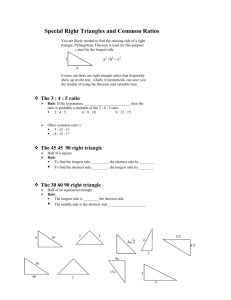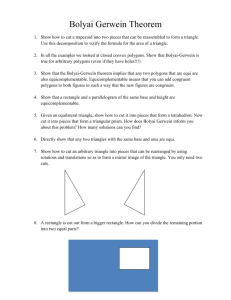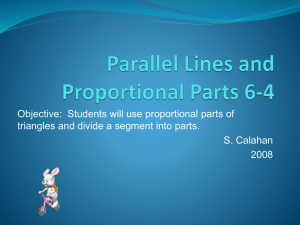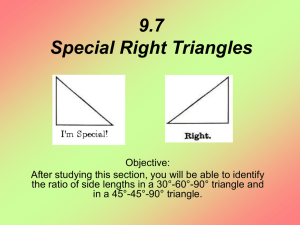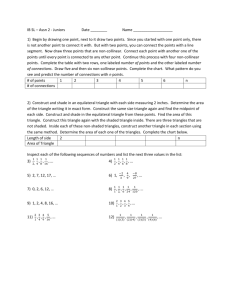Conjecture: Assume that all points in the Cartesian Plane are
advertisement
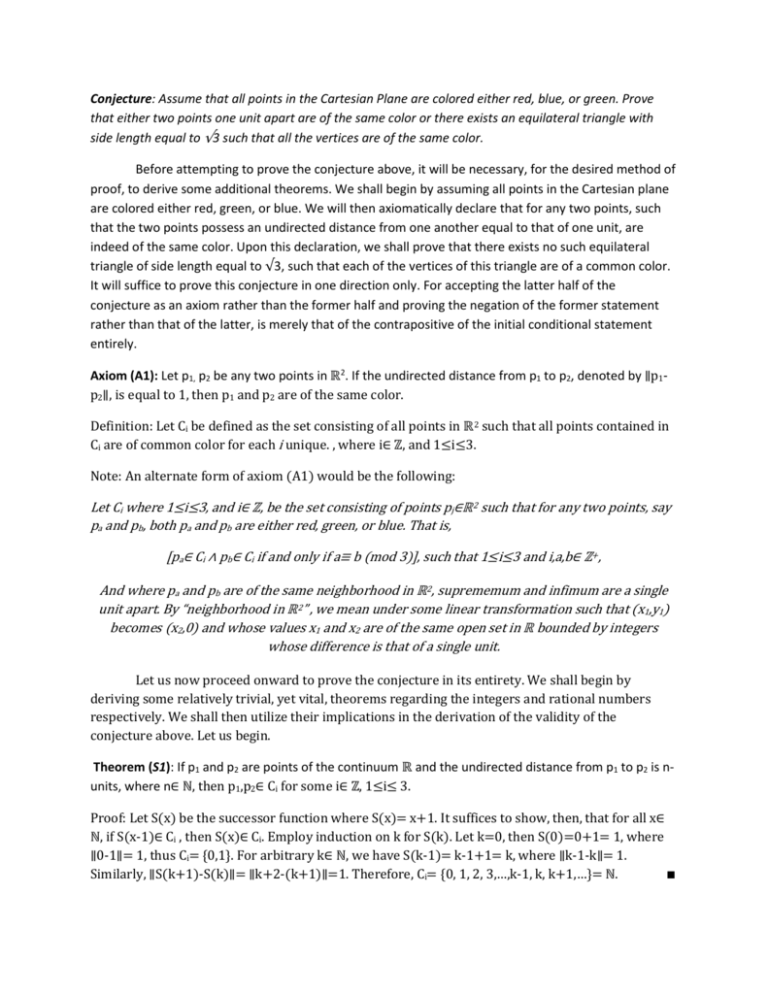
Conjecture: Assume that all points in the Cartesian Plane are colored either red, blue, or green. Prove
that either two points one unit apart are of the same color or there exists an equilateral triangle with
side length equal to √3 such that all the vertices are of the same color.
Before attempting to prove the conjecture above, it will be necessary, for the desired method of
proof, to derive some additional theorems. We shall begin by assuming all points in the Cartesian plane
are colored either red, green, or blue. We will then axiomatically declare that for any two points, such
that the two points possess an undirected distance from one another equal to that of one unit, are
indeed of the same color. Upon this declaration, we shall prove that there exists no such equilateral
triangle of side length equal to √3, such that each of the vertices of this triangle are of a common color.
It will suffice to prove this conjecture in one direction only. For accepting the latter half of the
conjecture as an axiom rather than the former half and proving the negation of the former statement
rather than that of the latter, is merely that of the contrapositive of the initial conditional statement
entirely.
Axiom (A1): Let p1, p2 be any two points in ℝ2. If the undirected distance from p1 to p2, denoted by ∥p1p2∥, is equal to 1, then p1 and p2 are of the same color.
Definition: Let Ci be defined as the set consisting of all points in ℝ2 such that all points contained in
Ci are of common color for each i unique. , where i∈ ℤ, and 1≤i≤3.
Note: An alternate form of axiom (A1) would be the following:
Let Ci where 1≤i≤3, and i∈ ℤ, be the set consisting of points pj∈ℝ2 such that for any two points, say
pa and pb, both pa and pb are either red, green, or blue. That is,
[pa∈ Ci ∧ pb∈ Ci if and only if a≡ b (mod 3)], such that 1≤i≤3 and i,a,b∈ ℤ+,
And where pa and pb are of the same neighborhood in ℝ2, suprememum and infimum are a single
unit apart. By “neighborhood in ℝ2” , we mean under some linear transformation such that (x1,y1)
becomes (x2,0) and whose values x1 and x2 are of the same open set in ℝ bounded by integers
whose difference is that of a single unit.
Let us now proceed onward to prove the conjecture in its entirety. We shall begin by
deriving some relatively trivial, yet vital, theorems regarding the integers and rational numbers
respectively. We shall then utilize their implications in the derivation of the validity of the
conjecture above. Let us begin.
Theorem (S1): If p1 and p2 are points of the continuum ℝ and the undirected distance from p1 to p2 is nunits, where n∈ ℕ, then p1,p2∈ Ci for some i∈ ℤ, 1≤i≤ 3.
Proof: Let S(x) be the successor function where S(x)= x+1. It suffices to show, then, that for all x∈
ℕ, if S(x-1)∈ Ci , then S(x)∈ Ci. Employ induction on k for S(k). Let k=0, then S(0)=0+1= 1, where
∥0-1∥= 1, thus Ci= {0,1}. For arbitrary k∈ ℕ, we have S(k-1)= k-1+1= k, where ∥k-1-k∥= 1.
Similarly, ∥S(k+1)-S(k)∥= ∥k+2-(k+1)∥=1. Therefore, Ci= {0, 1, 2, 3,…,k-1, k, k+1,…}= ℕ.
∎
Note: Notice that we employ the successor function rather than the identity function. In choosing
the successor function we simply omit the trivial case where the undirected distance between two
points is zero. For when zero, the two points chosen are in fact the same point and thus, the same
color.
Theorem (S2): Let p1 and p2 be any two points in ℝ2. If the undirected distance from p1 to p2,
denoted ∥p1-p2∥, is that of a/b, where a/b∈ Cj, then ((a+kb)/b)∈ Cj and a≡1(mod b).
Proof: Let p1 and p2 be points in the continuum ℝ, such that ∥p1-p2∥= a/b. Now, assume a/b∈ Cj
where Cj is not necessarily equal to Ci= ℕ. Then by axiom A1, we know that (a/b) +(1)= (a/b)
+(b/b)= ((a+b)/b)∈ Cj iff (a/b)∈ Cj. Furthermore, by theorem (S1), we know that ((a+kb)/b)∈ Cj
iff ((a+b)/b)∈ Cj for any k∈ ℕ. We have now only to show that a≡1 (mod b). From the propositions
of number theory; a≡1 (mod b) iff ((a-1)/b)= n∈ ℤ. Employ the method of “adding zero”:
(𝑎 − 1) + 1 + 𝑏 𝑎 − 1 1 𝑏
=
+ +
𝑏
𝑏
𝑏 𝑏
𝑏+1
𝑏+1
𝑎 + 𝑘𝑏
=𝑛+
𝑤ℎ𝑒𝑟𝑒 ( 𝑛 +
) 𝑖𝑠 𝑜𝑓 𝑡ℎ𝑒 𝑓𝑜𝑟𝑚 (
) 𝑎𝑛𝑑 𝑤ℎ𝑒𝑟𝑒 𝑎 = 1, 𝑏
𝑏
𝑏
𝑏
= 𝑏, 𝑘 = 𝑛 + 1.
We could generalize even further and declare that (x(a+kb)/b)∈ Cj iff ((a+kb)/b)∈ Cj where
x(a-1)≡x (mod b) but the result is trivial and unnecessary for we may as well let a=ax. And this
completes the proof.
∎
Note: We have proved that the set Ci consisting of one of three colors exhausts the entire set of
integers. Above we have shown that Cj consists of elements q of the rational field ℚ, such that q=
((a+kb)/b) where (a-1)≡1 (mod b). Furthermore, observe the necessity of the inclusion of
(a-1)≡ 1(mod b) in theorem (S2). For if (a-1)≠1 (mod b) then q may be any rational whatsoever
which would include the set ℕ= ℤ∪{0}. Thus, we would have Ci= Cj. However, although possible
that i=j, the statement i= j is undecideable under the axioms granted and cannot be proven either
true or false due to the independency of the statement. We can only show that certain rationals are
of the same set Cα for some α∈ ℤ, 1≤α≤3, and thus, of the same color. Furthermore, note that both
theorems thus far, have been show to be true in the continuum ℝ. Realize that our points in the
continuum are simply real numbers which we may define by the ordered pair (x,0) for any x∈ ℝ.
However, we may achieve any point (x,y)∈ℝ2 by imposing some linear transformation upon (x,0).
This holds for any set of points.
We are now in a position to prove the initial assertion regarding the existence of an
equilateral triangle of side length √3 with vertices of a common color given the assumption that all
points one unit apart are of a common color themselves.
Proof: Let it be shown that if two points in the Cartesian plane, say p1 and p2 are of an undirected
distance of one unit form one another where p1,p2∈Ci for some i∈ℤ, with 1≤i≤3, then there does not
exist an equillaterial triangle of side length equal to √3 with all vertices of the same set Cα where α∈
ℤ, 1≤∝≤3.
Let there exist an equilateral triangle, and let us call this equilateral triangle ABD. Let there
exist an altitude AC such that AC⊥DB. Furthermore, let AC bisect ABD such that AC forms two
triangles within ABD, namely, ACD and ACB. If the hypotenuse of an equilateral triangle is that of
√3, then the magnitude of the altitude bisecting the angle adjacent to the hypotenuse is given by:
2
2
√((√3) − ((√3)
2
3
9
= √3 − (4) = √4 = 3/2.
By theorem S2, the quantity 3/2 is of the form ((a+kb)/b), where a=1, b=2, and k=1. Thus, A∈ Ci
and C∈ Ci, for some i as previously defined, and where, again, the segment AC defines the altitude of
our equilateral triangle. Thus, the vertex A is in Ci. Assume the following:
𝑎 + 𝑘𝑏
2𝑎 + 2𝑘𝑏 2(𝑎 + 𝑘𝑏)
√3
=(
) → √3 =
=
.
2
𝑏
𝑏
𝑏
Although,
2(𝑎+𝑘𝑏)
𝜖
𝑏
ℚ 𝑎𝑛𝑑 √3 ∉ ℚ , it is quite tempting to assert verification on the basis of logical
absurdity. However, such a declaration would be without merit for theorem S2 is not a
biconditional statement. Thus, we shall rely on the theorems of analysis regarding convergent
sequences.
From analysis, we know that for any two points, say p1 and p2, both contained in the
continuum ℝ, there exists ℵ0 of rationals, say m/n, such that, p1<m/n <p2. Define <Px> as the
sequence (set) equal to Ran(P(x)) for 𝑃(𝑥) = √3-(2((a+kb)/b), where a,b,k are all constant
integers and let us show that inf(<Px>)≠ 0; that is, we shall exhaust the entire set Cj consisting of
elements of the rational field ℚ as defined in theorem S2 and show that Cj does not consist of the
element √3. This will also include the color set consisting of the natural numbers since ℕ⊂ ℚ. The
result is trivial, since we may get arbitrarily close to √3, we will never achieve a value of P(x) such
that P(x)= 0 and thus the inf(<Px>)≠0. In fact, we will get so close to √3 that we will be but merely
a point away from achieving the value √3. And by axiom A1, pa∈ Ci and pb∈ Ci iff a≡ b (mod 3). If pa
is to be infinitesimally close to pb, then we may let a=1 and b=2, which implies that 1≡2 (mod 3),
which is absurd by axiom A1. Thus, there exists at least one vertex, B or D, of the equilateral triangle
erected, such that B or D is not contained in the same set as vertex A. And this completes the proof.
∎
Theorem: Assume all points in the Cartesian plane are colored red, blue, or green. If two points, one
unit apart are the same color, then there does not exist an equilateral triangle in the Cartesian plane
with side length equal to √3 such that all the vertices of the triangle are of the same color.

